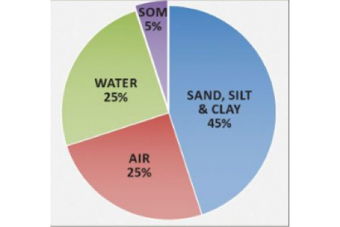Soil Structure
What is soil structure?
Soil structure is the arrangement of soil particles (sand, silt, clay and organic matter) into what is know as granules, crumbs or blocks (how the soil is bound together).
Well-structured soils are usually crumbly and friable and have plenty of pore space to allow water and air movement to ensure healthy root development. In fact, and perhaps surprising, 50% of healthy soil is made up of water and air.

Components of soil by volume
Why is soil structure important?
Good soil structure ensures plants have access via their roots to nutrients, water and air. Soil without air becomes anaerobic, noticeable by an unpleasant ‘stagnant’ smell. Good, well-drained soil should have little to no smell at all.
What to look out for in our own gardens?
In our own gardens we can look at cracks in the soil, do they inter-connect to allow for water drainage and air movement? Are there any hard, compacted layers, either on the surface or at the normal digging depth of a spade?
How we can improve soil structure?
Add plenty (up to 7.5cm) of organic matter to the surface of soil. This can be garden compost, leaf mould or well-rotted farmyard manure, to name just a few. However, leave the area just around the crown of plants without mulch.
Leave the digging to the worms and other organisms in the soil. This is far kinder to the soil and to those digging.
Avoid walking on the soil unnecessarily, particularly when the soil is wet or frozen.
